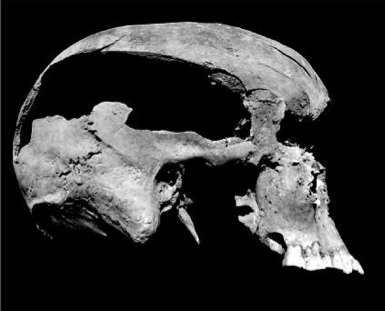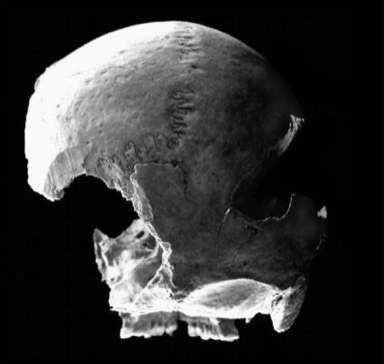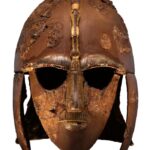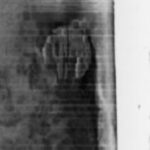Buried within Hrísbrú cemetery in the Mosfell Valley (Mosfellsdalur), Iceland, are the remains of 21 individuals from the Viking Age. One of these individuals met with a violent end around at the age of 40-45, sometime around 960 AD (roughly between 890 and 990 AD). He has come to fame under the name of the “Axed Man of Mosfell”, on account of the two traumatic wounds to his head. With pieces of his skull missing, this man suffered a truly brutal end to his life.
In addition to this man’s clearly rough death, careful osteological and stable isotopes analysis indicates that he seemed to have had a rough childhood as well. The man was likely the son or grandson of one of the first waves of immigrants to Iceland in the late 9th century AD. His teeth tell us that he likely went through a period of illness between the ages of 3 and 6, and his stature suggests stunted growth due to poor health. And it seems things did not improve much during adulthood: his teeth suggest a slight dental disease at the time of his death, and his skeleton shows evidence of an extremely labour-intensive life which resulted in osteoarthritis throughout his body. This man did so much heavy lifting that not only can we see the physical damage done to his shoulders, but we can pinpoint the muscles and ligaments which were being overused! Ethnographic and ethnohistorical studies suggest that these actions were either caused by ploughing, house building, hunting, or ship maintenance. This man worked himself to the bone until the day he was brutally murdered.
Considering the nature of the final two injuries he sustained, it is safe to say that this was definitely a homicide. One cut runs along the right side of his head, above where the ear would have been. The cut had broken through the inner surface of the skull, meaning the weapon would have buried itself deep into his brain. Now, if this wasn’t enough to take him out, the other cut (though we can’t tell which one was first) removed a whole disc-shaped slice off the back of his skull, taking a portion of the brain as well. At this point it is hard to tell if the major loss of blood, concussive force, or the loss of bits of brain was what killed him, but based on our very thorough knowledge of anatomy today, we can determine that the attacker (and any witnesses that were too close) was probably drenched in the Axed Man’s blood.
Now, why is he called the “Axed Man”? The side cut did not slice through the entire skull, and the edges are quite consistent with other evidence we have of axe wounds. Swords tend to cleanly cut into bone, while axes tend to show an additional layer of blunt-force trauma in addition to the cut itself. The brutal side wound in this case is consistent in form with this type, and so it has been concluded that the man was cut down with an axe (possibly one of those famous Viking battle-axes).

What about the back cut? This was a clean cut that went all the way through, so we know it was inflicted by a very sharp weapon. But the cut marks show some striations, suggesting that it came from a heavily-used weapon with plenty of notches on the blade—this was not a shiny new toy, but had definitely seen some action already. The width of the cut (90mm or more), however, does suggest a longer sharp edge than a standard axe, which is why it is believed that the back cut was made by a sword.

So, we have means, but what of motive? Now, if we take a step back and review a little bit of the culture of the day, Icelandic saga literature indicates that this time and place was rife with violence and generational blood feuds. In fact, the Saga of Gunnlaug Serpent-Tongue describes a killing in Mosfell around 1010 AD, which was part of one of these ongoing feuds. While it is a possibility that our Axed Man was part of this event, or an earlier attack that eventually culminated in the 1010 AD killing, this line of thinking is entirely speculative. The nature of his involvement (if any) is virtually impossible to determine while being this far removed from the events; the Axed Man could have been a willing and active participant, or an unwilling by-stander. It should also be remembered that saga literature is only semi-historical, and so it is generally unwise to put too much trust in specific dates or to assume that every event described actually happened—nevertheless, 1010 AD is not that far removed, in archaeological terms, from the range provided for the death of the Axed Man of Mosfell.
So, we have two injuries made by two different weapons (and, logically, by different attackers), either one of which would have been deadly on its own. It is hard to imagine a scenario where one of the attackers struck and the Axed Man kept moving, only to be struck by another a little while later. Basic sense would suggest that the two injuries were almost simultaneous: the axe-wielder might have been facing our Axed Man while the sword-wielder flanked him, both striking at once. It is thus possible that the Axed Man was struck down in the middle of combat, likely done in by the chaotic nature of battle (they were coming from multiple sides!). One can only hope that the Axed Man’s death came quickly, and perhaps that he managed to deal a killing blow to one of his attackers in return (though, of course, that depends on whose side you were on).
Text: Cindy Levesque. Copyright 2021 Scandinavian Archaeology.
Cover image: Christopher Nichols & Lovisa Sénby Posse. Copyright 2021 Scandinavian Archaeology.
Further reading:
Walker et al. 2012. The Axed Man of Mosfell: Skeletal Evidence of a Viking Age Homicide, the Icelandic Sagas, and Feud. The Bioarchaeology of Individuals, edited by A.W.L. Stodder & A.M. Palkovich. University of Florida Press.
About the author
Cindy Levesque
Cindy G Levesque is a biological anthropologist and archaeologist from New Brunswick, Canada. She completed her Bachelor of Arts degree at the University of New Brunswick, and her Master of Science degree at Sheffield University in England. She currently lives in Uppsala, Sweden.



So interesting and my DNA history has my ancestry from Scandinavia so a very interesting read for me .